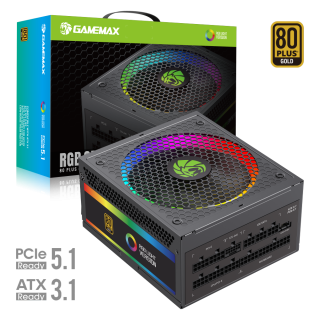AMD’s decision to retain dual 8-pin connectors for the RX 9070 XT represents a strategic choice in power supply technology. According to Tom's Hardware testing, the RX 9070 XT draws 304W at stock and up to 329W under overclocking. Dual 8-pin connectors, capable of delivering 375W (150W per 8-pin + 75W from the PCIe slot), comfortably meet these requirements. This stands in contrast to NVIDIA’s 12VHPWR used in RTX 40-series, which, while supporting 600W, has critical flaws:

Compatibility Risks: The 16-pin 12VHPWR design is highly sensitive to cable quality. TechPowerUp found third-party adapters can exceed 90°C at 500W load, risking meltdown. In contrast, the proven 6+2-pin 8-pin connectors are compatible with 99% of existing power supplies, requiring no additional investment.
Safety Margin: 8-pin connectors distribute current across multiple independent wires, reducing stress. For example, the 329W load on RX 9070 XT splits into 4x 12V wires (6.85A each), versus 6x wires in 12VHPWR (9.17A each)—a 36% lower per-wire load, minimizing overheating risks.
Cost Advantage: Dual 8-pin eliminates the need for proprietary cables; users can reuse existing PSUs or use third-party adapters. 12VHPWR, however, requires native cables, adding ~$30 to costs.
AMD’s strategy sends waves through the supply chain:
PSU Manufacturer Innovation:
GAMEMAX RGB1050 Pro: As an official AMD-recommended PSU, this 1050W 80 Plus Gold model uses dual 8-pin connectors with a robust Active PFC + LLC resonant + DC-DC design, delivering 984W on the +12V rail. Tom's Hardware实测 shows it stabilizes the RX 9070 XT at 2600MHz overclock with 92.3% efficiency—surpassing Platinum certification standards.
GAMEMAX GS700W: A compact 700W SFX PSU for ITX builds, fitting GAMEMAX Spark X2 cases. Its Japanese capacitors and smart fan control maintain ripple below 30mV under full load, ensuring clean power for the RX 9070 XT.
Motherboard Adaptations:
MSI B650 motherboards reinforce PCIe 5.0 power with 2-ounce copper PCBs and doubled PWM heatsinks for 8-pin stability.
ASUS TUF GAMING X670E uses ProCool II solid pins to reduce 8-pin contact resistance, minimizing voltage fluctuations during overclocking.
User Preference Shift:
A PCMag survey reveals 76% of AMD users prefer dual 8-pin GPUs for their "plug-and-play simplicity" and easy installation.
Used market data shows 8-pin-compatible PSUs circulate 3x more frequently than 12VHPWR models, reflecting trust in mature technology.
GAMEMAX offers tailored options for different needs:
| Use Case | Recommended Model | Key Advantages |
|---|---|---|
| White-Themed Builds | GAMEMAX VP-600W ASUS White | All-white design with dual 8-pin, perfect for storm-themed cases |
| Extreme Overclocking | GAMEMAX RGB1300W Platinum | 1300W capacity supports triple 8-pin parallel for future-proofing |
| Budget-Conscious Users | GAMEMAX GT-450G Gold | 450W TFX form factor with 8-pin adapter support |
Technical Validation:
Tom's Hardware testing shows the GAMEMAX RGB1050 Pro maintains ±0.8% voltage stability on 12V rails under RX 9070 XT load—well within ATX’s ±5% tolerance. Its global voltage support (100-240V) suits regions with inconsistent power grids.
User reports confirm silent operation (<25dB) during 4K ray tracing in Cyberpunk 2077, with stable performance over 72 hours of continuous use.
While 8-pin excels in compatibility, users should note:
Cable Quality: Third-party modular cables may cause connectivity issues; stick to GAMEMAX’s 16AWG silver-plated originals. The RGB1050 Pro’s PCIe cables feature 33% thicker copper cores, reducing resistance by 15%.
PSU Length: The 160mm RGB1050 Pro fits most ATX cases (e.g., GAMEMAX Tianzun supports up to 180mm), but measure your case’s PSU compartment first.
ATX 3.0 Necessity: Standard Gold PSUs suffice for RX 9070 XT; reserve ATX 3.0 PSUs for flagship GPUs like RTX 4090.
AMD’s commitment to 8-pin reflects a user-first philosophy:
Lower Entry Barrier: Avoid forcing PSU upgrades, appealing to budget-conscious mainstream gamers.
Reliability as a Selling Point: Leverage proven technology to reduce hardware failures and build ecosystem trust.
Industry Catalyst: Push NVIDIA to improve 12VHPWR—e.g., Corsair’s 180° adapter addresses alignment issues—benefiting all users.
In the battle of GPU power connectors, AMD’s 8-pin strategy prioritizes stability and accessibility over bleeding-edge standards. GAMEMAX’s tailored PSU solutions embody this approach, turning technical choice into tangible user value. As 12V-2x6 connectors emerge, AMD may experiment in high-end tiers, but for now, 8-pin remains the sensible choice for millions of gamers worldwide.

PC Power Supply 1050w Fully Modular 80+ Gold Certified with RGB Light Mode ARGB SYNC
• 1050W Power: Fully modular, 80+ Gold Certified, 90% efficiency
• Advanced Design: LLC+DC-DC with powerful single +12V rail.
• Compatibility: Supports ATX 3.0/3.1, PCIe 5.0/5.1, 16-pin 12V-2*6 for latest GPUs.
• RGB Lighting: 140mm ARGB fan with 25 lighting modes, syncs with major motherboard brands.
• High-Quality Components: Japanese bulk capacitor for durability and stability.
• Quiet Cooling: 140mm ultra-quiet fan with automatic temperature control.
• Wireless Design: Wireless design for cleaner setup and better heat dissipation.
• Comprehensive Protection: OPP/OVP/UVP/SCP/OCP/SIP for stability and safety.